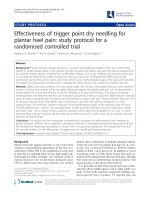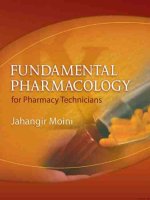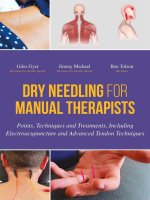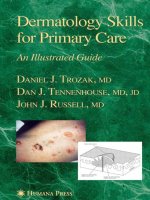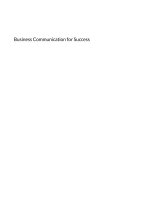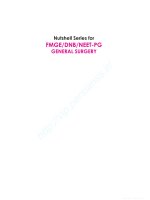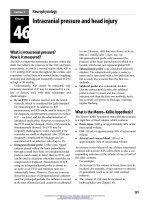Ebook Dry needling for manual therapists: Part 1
Bạn đang xem bản rút gọn của tài liệu. Xem và tải ngay bản đầy đủ của tài liệu tại đây (1.46 MB, 123 trang )
DRYNEEDLINGFOR
MANUALTHERAPISTS
ofrelatedinterest
TheActivePointsTest
AClinicalTestforIdentifyingandSelectingEffectivePointsforAcupunctureandRelatedTherapies
StefanoMarcelli
ISBN9781848192331
eISBN9780857012074
DRYNEEDLINGFOR
MANUALTHERAPISTS
Points,TechniquesandTreatments,Including
ElectroacupunctureandAdvancedTendonTechniques
GilesGyer,JimmyMichaelandBenTolson
LONDONANDPHILADELPHIA
MedicalimagesprovidedbyAlilaMedicalImages.
PhotostakenbyFrancesTolson(www.evokepictures.co.uk).
Firstpublishedin2016
bySingingDragon
animprintofJessicaKingsleyPublishers
73CollierStreet
LondonN19BE,UK
and
400MarketStreet,Suite400
Philadelphia,PA19106,USA
www.singingdragon.com
Copyright©GilesGyer,JimmyMichaelandBenTolson2016
Allrightsreserved.Nopartofthispublicationmaybereproducedinanymaterialform(includingphotocopyingor
storingitinanymediumbyelectronicmeansandwhetherornottransientlyorincidentallytosomeotheruseofthis
publication)withoutthewrittenpermissionofthecopyrightownerexceptinaccordancewiththeprovisionsofthe
Copyright,DesignsandPatentsAct1988orunderthetermsofalicenceissuedbytheCopyrightLicensingAgencyLtd,
SaffronHouse,6–10KirbyStreet,LondonEC1N8TS.Applicationsforthecopyrightowner’swrittenpermissionto
reproduceanypartofthispublicationshouldbeaddressedtothepublisher.
Warning:Thedoingofanunauthorisedactinrelationtoacopyrightworkmayresultinbothacivilclaimfordamages
andcriminalprosecution.
LibraryofCongressCataloginginPublicationData
ACIPcatalogrecordforthisbookisavailablefromtheLibraryofCongress
BritishLibraryCataloguinginPublicationData
ACIPcataloguerecordforthisbookisavailablefromtheBritishLibrary
ISBN9781848192553
eISBN9780857012029
Contents
PARTI
BACKGROUND
Chapter1
Introduction
Chapter2
AShortHistoryofAcupuncture
PARTII
THEORIESAROUNDDRYNEEDLINGAND
TRADITIONALCHINESEMEDICINE
Chapter3
MyofascialPainandTriggerPoints
Chapter4
PhysiologicalMechanismofAcupunctureinPainControl
Chapter5
UnifyingTheoriesofAcupuncture:Fascia,PiezoelectricityandEmbryology
Chapter6
CurrentResearchintoDryNeedling
PARTIII
PREPARINGFORTREATMENT
Chapter7
SafetyAspectsofDryNeedling
Chapter8
Palpation
Chapter9
Deqi
Chapter10 PlanningTreatment
PARTIV
NEEDLINGTECHNIQUES
Chapter11 Muscles:TechniquesandClinicalImplications
Chapter12 Electroacupuncture
Chapter13 TendinopathyandTendonTechniques
SubjectIndex
AuthorIndex
PartI
BACKGROUND
Chapter1
Introduction
T
hisbookisprimarilyforhealthprofessionalswhoaretreatingmusculoskeletal(MSK)
conditions and who wish to incorporate acupuncture into their practice. We
acknowledgethatacupuncturecantreatconditionsotherthanMSK,butthatisbeyondthe
scopeofthebook.
Physical therapists see many MSK problems in clinic, which makes them ideal
candidates to incorporate acupuncture into their practice. Musculoskeletal problems of
various types are often the most common reasons for patients to seek care from
acupuncturists,representingonethirdtoonehalfofallvisits(Shermanetal.2005).Inone
study of Chinese patients (Mao et al. 2007), patients presented with pain-related
musculoskeletal complaints such as back and neck pain (53%), arthritis (41%),
neurologicalcomplaintssuchaspost-strokerehabilitationandfacialparalysis(23%),and
weightloss(10%).IntheUnitedKingdomacupunctureisusedin84percentofchronic
painclinics(WoollamandJackson1998).
Acupuncture has become more accepted by Western medicine over the last 30 years
andhasseenanexponentialgrowthinitspracticeworldwide(GuerreirodaSilva2013).
Asthepracticeofacupuncturehasgrown,sotoohastheevidencebase.Theadvantagesof
using acupuncture are well documented and include an immediate reduction in local,
referred and widespread pain, restoration of range of motion and muscle activation
patterns,andanormalizationoftheimmediatechemicalenvironmentofactivemyofascial
triggerpoints(Dommerholt2011).Aswellasthesewell-documentedeffects,acupuncture
canhavesimultaneouswidespreadeffectsatmultiplesites.
Acupunctureaspartofmanualtherapyisrarelyastand-aloneprocedureandshouldbe
part of a broader physical therapy approach. Other approaches, including soft tissue
mobilization,manipulation,therapeuticexerciseandfunctionalretraining,shouldbeused
in combination with acupuncture. For example, after deactivation of myofascial trigger
points,patientsshouldbeeducatedinappropriateself-caretechniqueswhichmayinclude
specific stretches of the involved muscles and self-massage techniques (American
PhysicalTherapyAssociation2013).
As the appetite for acupuncture has grown, there now exist varying standards of
training. The requirements for acupuncture training have yet to be provided and vary
considerably in practice. Broadly speaking there are two main training routes for
acupuncture:coursesforlaypersonsandcoursesformedicallyqualifiedpractitioners.
Thosecourseswhicharemainlyforlaypersonsaregenerallyverycomprehensiveand
willincludeamixtureofstandardWesternanatomyandpathologywithalargepercentage
oftraditionalChinesemedicine(TCM).TCMtheoryisextremelycomplex,takesalong
timetolearnandincludespulseandtonguediagnosisamongstothertechniques.
The courses attended by medically qualified practitioners are usually much shorter.
Thisisbecause,inthecaseofdoctorsandalliedhealthprofessionals,theirknowledgeof
diagnosis, pathology, anatomy, physiology, microbiology and other treatment techniques
thatcanbeusedatthesametimeasacupuncturecanbetakenforgranted.
White(2009,p.33)definesdryneedling(alsoknowasWesternmedicalacupuncture)
as a ‘therapeutic modality involving the insertion of fine needles; it is an adaptation of
Chineseacupunctureusingcurrentknowledgeofanatomy,physiologyandpathology,and
the principles of evidence-based medicine. Although Western medical acupuncture has
evolvedfromChineseacupuncture,itspractitionersnolongeradheretoconceptssuchas
yin/yang and circulation of qi, and regard acupuncture as part of conventional medicine
ratherthanacomplete“alternativemedicalsystem”.’Forconvenience,however,theterm
acupuncturewillbeusedthroughoutthisbook.
Hong(2013,p.593)describesacupunctureascovering‘adiverseacademicfieldthat
spansfromancientmedicalhistorytothemostadvancedcontemporaryneurophysiology’.
Hecontinues:‘Acupunctureasatreatmentforpainencompassesmuchmorethansimply
needling:itinvolvesacomplexinteractionandcontextthatmayincludeempathy,touch,
intention,attention,expectationandconditioning.’
Theterm‘dryneedling’isoftenusedtodifferentiatethistechniquefrommyofascial
triggerpointinjections.Myofascialtriggerpointinjectionsareperformedwithavarietyof
injectables, such as: procaine, lidocaine and other local anaesthetics; isotonic saline
solutions;non-steroidalanti-inflammatories;corticosteroids;beevenom;botulinumtoxin;
andserotoninantagonists(Dommerholt,delMoralandGröbli2006).
Many acupuncturists see the use of so-called dry needling/Western medical
acupunctureasaninfringementoftherightsoftraditionalacupuncturepractitioners.Itis
the position of some organizations that any intervention utilizing dry needling beyond
trigger point dry needling is the practice of acupuncture, regardless of the language
utilizedindescribingthetechnique.Acupuncturistswillarguethatbyusingacupuncture
intheirpracticepractitionersmayinadvertentlybeaffectingthewholeorganismwithout
realizingit.
Whether acupuncture falls within the confines of a single discipline or should be
incorporatedintophysicaltherapyremainsaquestiontobeansweredbyindividualsand
therespectiveorganizationsorgoverningbodies.Currentlyinsomepartsoftheworldthis
has resulted in a turf war where legislation has been passed banning the use of
acupuncturewithinmanualorphysicaltherapy.
At its heart, Western medical acupuncture has a scientific rationale. Acupuncture
trainingprogrammesmustprovidestudentswithsufficientknowledgetocommunicatethe
scienceandtheoriesunderlyingacupunctureinconventionalmedicallanguage.
Resistance to implementation of broad integrative clinical training has encouraged
other professions such as medicine, chiropractic and physical therapy to include
acupuncture in their scope of practice, redefined as percutaneous electrical nerve
stimulation, transcutaneous electrical nerve stimulation and dry needling (Dommerholt
2011),whichexplainthemodalityinconventionalmedicallanguage(Stumpf,Kendalland
Hardy2010).
One current argument against acupuncture being used within modern healthcare
settings in the West is that acupuncture mechanisms (how it works) cannot depend on a
philosophical or political debate that transcends clinical practice (Stumpf et al. 2010).
Only through a universal way to describe how acupuncture works, along with safe
working practices and treatment strategies, will a continued adoption of acupuncture
theoryandunderstandingbepromoted.
Stumpfetal.(2010)arguethatthegreatestbarrierstointegration,however,originate
with acupuncture training programmes based on European metaphysical ideas (Kendall
2008) which therefore do not ensure that graduates have a sufficient understanding of
quality biomedical knowledge and mainstream medicine, including primary care, or are
able to evaluate research competently (Hammerschlag 2006). Without adequate
knowledgeorexposuretomainstreammedicine,graduatesareunpreparedto(a)function
effectively in an integrative healthcare team, (b) provide competent primary care to
patients,or(c)makeappropriatereferralstophysiciansandothermainstreamproviders.
The focus should be on expanding acupuncture to populations that might not
necessarily be able to access acupuncture through private practice. Just as spinal
manipulation should not be exclusive to one profession, so should the practice of
acupuncture. Our hope is that traditional acupuncturists will study the known Western
medicaltheoriesofhowacupunctureworksandwillgiveaflavouroftheunderstandingof
howtraditionalacupunctureworksfromanenergeticperspective.Onlybyensuringhigh
educationalstandardsfortrainingphysicaltherapistswillacupuncturebepractisedsafely,
andthisbookisnotintendedtoreplacesuchtraining.
Only by integrating different modalities such as acupuncture into our practice will
patients benefit fully. The practice of integrative medicine has emerged as a potential
solution to solve complex problems seen in our patient population (Maizes, Rakel and
Niemiec2009).
Good medicine is based on good science. It is inquiry-driven and open to new
paradigms.Itisbothpracticalandpragmatic.AlthoughWesternacupuncturehasevolved
fromTCM,wearenotdismissingtheTCMapproachtoacupuncture.Westernmedicineis
continually evolving and the explanations given are based on current evidence. As the
evidence continues to grow, we may be able to explain more of the mechanisms of
acupuncture.Thereisnowmuchpositiveevidencetosupporttheuseofacupuncture,and
thisisoutlinedlaterinthebook.
Thetechniquesinthebookaretheonestheauthorsfrequentlyuseinclinicalpractice.
Obviously this book is intended only as a supplement for acupuncture training. Perhaps
theuseofacupunctureshouldbepatient-centredandnotdrivenbyprofessionaldisputes.
It is our hope that by writing this book more health professionals will be able to use
acupunctureintheirpracticeandhelpthemanypatientswhoaresufferinginpain.
References
AmericanPhysicalTherapyAssociation(APTA)(2013)DescriptionofDryNeedlinginClinicalPractice. Alexandria,
VA:
APTA
Public
Policy,
Practice,
and
Professional
Affairs
Unit.
Available
at
www.apta.org/StateIssues/DryNeedling/ClinicalPracticeResourcePaper,accessedon15July2015.
Dommerholt, J. (2011) ‘Dry needling – peripheral and central considerations.’ Journal of Manual and Manipulative
Therapies19,4,223–227.
Dommerholt,J.,delMoral,O.M.,andGröbli,C.(2006)‘Triggerpointdryneedling.’JournalofManual&Manipulative
Therapy14,4,E70–E87.
Guerreiro da Silva, J.B. (2013) ‘Integrative medicine, integrative acupuncture.’ European Journal of Integrative
Medicine5,83–86.
Hammerschlag, R. (2006) ‘Evidence-based complementary and alternative medicine: back to basics.’ Journal of
AlternativeandComplementaryMedicine12,349–350.
Hong,H.(2013)Acupuncture:TheoriesandEvidence.Singapore:WorldScientificPublishing.
Kendall,D.E.(2008)‘Energy–meridianmisconceptionsofChinesemedicine.’Schweiz.Zschr.GanzheitsMedizin20,2,
112–117.
Maizes,V.,Rakel,D.,andNiemiec,C.J.D.(2009)‘Integrativemedicineandpatientcentredcare.’Explore(NY)5, 5,
277–289.CommissionedfortheIOMSummitonIntegrativeMedicineandtheHealthofthePublic.
Mao, J.J., Farrar, J.T., Armstrong, K., Donahue, A., Ngo, J., and Bowman, M.A. (2007) ‘De qi: Chinese acupuncture
patients’experiencesandbeliefsregardingacupunctureneedlingsensation–anexploratorysurvey.’Acupunct.Med.
25,4,158–165.
Sherman,K.J.,Cherkin,D.C.,Eisenberg,D.M.,etal.(2005)‘Thepracticeofacupuncture:whoaretheprovidersand
whatdotheydo?’AnnalsofFamilyMedicine3,151–158.
Stumpf,S.H.,Kendall,D.E.,andHardy,M.L.(2010)‘Mainstreamingacupuncture:barriersandsolutions.’Journal of
Evidence-BasedComplementary&AlternativeMedicine15,1,3–13.
White,A.(2009)‘Westernmedicalacupuncture:adefinition.’Acupunct.Med.27,33–35.
Woollam,C.H.M.,andJackson,A.O.(1998)‘Acupunctureinthemanagementofchronicpain.’JournalofAnaesthesia
53,593–595.
Chapter2
AShortHistoryofAcupuncture
I
tisimportantforthepractitionertohaveanunderstandingoftheoriginsofacupuncture
as it puts current practice into context. Also, it is useful to understand some of the
principles and techniques in traditional Chinese medicine (TCM), as it is from these
techniquesthatWesternacupuncturehasevolved.Someclinicaltrialsandresearchpapers
may also use TCM methodology and traditional acupuncture points, so being able to
understandandevaluatethetreatmentprotocolsandlocationsisofbenefitwhenforming
one’s own clinical reasoning and opinions of such research. This chapter outlines some
currentthinkinginTCMandhowthatmightdifferfromaWesternmedicalapproach.
Before the discussion of the origins of acupuncture begins, it must be stated that
acupunctureisjustonepartofanancientmedicalsystem.Typicallytherearefourmain
disciplinesthatformpartofTCM:
•
acupuncture
•
herbalmedicine
•
Chinesemassage/bodywork/physicaltherapyknownastuina(whichmeans‘push
andgrasp’)
•
Chineseexercisesuchasmartialarts,taichi,qigongandesotericpractices.
ThesedisciplinesarestillinuseinChinaandotherpartsoftheOrienttodayand,when
combined, provide a powerful tool for healing. Treatments draw from all aspects of
Orientalmedicine:acupuncture,bodywork,exercise,meditationandherbalmedicine.
For example, in China, tui na is one of the most commonly used modalities in the
practice of TCM. It includes techniques such as pushing (tui) and grasping (na) of soft
tissue. Tui na is a manual therapy based on the principles of TCM aimed at restoring
health and treating various clinical conditions, primarily MSK conditions. Tui na has
developed and is now incorporated into other clinical disciplines, such as acupuncture,
gynaecology and paediatrics. Tui na uses a variety of manual techniques guided by the
theoryofTCM.ThephilosophyofTCMstronglyinfluencestheattitudeandapproachof
tuinapractitionerstowardshealthcare(WorldHealthOrganization2010).
ThepracticeofherbalmedicineisonethatcanbetracedbacktothethirdcenturyAD
wheretheclassificationofherbshadalreadybegun.Theclassificationcontinuedandwas
documented in works such as The Compendium of Materia Medica, an impressive 52
volumes that described 1892 herbs. In clinical practice, traditional diagnosis may be
followed by the prescription of complex and often individualized remedies. Although
animalandmineralmaterialshavebeenused,theprimarysourceofremediesisbotanical.
Herbsaretakenindividuallyoraspartofaprescriptionwhereacombinationofherbsis
used,typicallybetweensixandnineherbsperprescription.Aherbalist’sentirepharmacy
maycontainbetween200and600potentialsubstances(Yuenetal.2012).
TheuseofherbalremediesiswidespreadinChina.Ergil,KramerandNg(2002,p.2)
describetheextentofherbalmedicineasfollows:‘Itwasoncecustomaryforfamiliesto
haveahouseholdrepertoireofherbalformulaetotreatmedicalproblemsandtoaddress
lifechanges(pregnancy,menopause,oldage)andtheseasons.Somefamiliesretain,and
especially older patients may continue to follow, these practices.’ Large pharmaceutical
companies are currently investing and researching the active ingredients in many of the
herbsusedinTCM.
Lewith (1982) describes the first attempt at recording disease dating back to around
1500BCduringtheShangDynasty.Tortoiseshellswithinscriptionswerefound,anditis
thoughtthatthesewereusedfordivinationintheartofhealing.AswithmuchofTCM’s
history, the philosophical basis of many of these findings indicates that practitioners
soughttoseekharmonybetweenthelivingandtheirdeadancestors,andthegoodandevil
spiritsthatinhabitedtheearth.
Another huge milestone in the development of acupuncture is TheYellowEmperor’s
CanonofInternalMedicine.ThisisthefirstChinesemedicaltexttodescribeacupuncture
and is in a question-and-answer format between the Yellow Emperor and one of his
ministers.Theacademicdivergenceofthoughtsinthisbooksufficientlyindicatesthatitis
neither a work of a single individual, nor medical achievement of a certain period or a
local region, but rather the summarization of experiences of many medical practitioners
over a long time. This text dates possibly (as sources vary) to as early as the second
centuryBC.Latertextsevolvedandincludedadescriptionofthechannels(acupuncture
channels), functions of the acupuncture points, needling techniques, types of qi,
descriptionofdiseasesandlocationofacupuncturepoints.
Collectively these early but comprehensive texts are known as the Chinese medical
classicsandarethephilosophicalfoundationforthepracticeofChinesemedicine.TCM
practitioners continually refer back to these sources to inform current practice. These
documents contain a comprehensive source of theoretical and clinical information (Neal
2013).
Mainsourcesofknowledgeanddevelopment
The roots of acupuncture and Chinese medicine developed over a long period of time,
drawinguponavarietyofsources.WangJu-YiandRobertson(2008)andDenmei(2003)
describesixmainsourcesofknowledgeanddevelopmentofacupuncture.
1.Earlymassage
Every early civilization has some form of touch therapy and China is no exception.
Massagetherapypredatesacupunctureandisstillinusetoday.Massagetherapyiscalled
tuinainChina,translatedastui(push)andna(grasp),givinganinsightintohowitworks.
Itwaspreviouslycalledanmo:an(pressing)andmo(rubbing).Acupuncturistswilloften
use tui na alongside acupuncture for more effective treatments, and when studying in
Chinastudentshavetolearnbothtuinaandacupuncture,givinganindicationoftheclose
relationshipofthetwoseparatedisciplines.
Throughtimethistuinagrewintoacohesivebodyofknowledgeandwasusedtotreat
a variety of conditions. The practice of tui na can focus on painful areas, acupuncture
pointsandacupuncturechannels.Todaytherangeofconditionstreatedbytuinaincludes
musculoskeletalconditions,gynaecology,paediatricsandrehabilitation,andthetechnique
iswidelyusedinhospitalsthroughoutChina.Agoodexampleofitsuseinthetreatmentof
childhooddiseaseswasfirstdescribedinthebookTheMassageofLaoZibyDrSunSi
Miao(AD 590–682). Infantile tui na was the treatment of choice during imperial times,
especially integrated with gao mo (the application of external herbal preparations as
ointments/tinctures/pastes).
One proposition is that pressing on certain points away from painful areas relieved
pain/discomfort.Forexample,rubbingapointnearthewristrelievedstomachache.This
led to practitioners searching for more points away from the area of pain that would
relieve the main complaint. Over time more areas and points were found and used on a
frequentbasistohelpawidevarietyofconditions.Particularpointsweremoreeffective
for certain conditions and that knowledge was passed on to other practitioners and
eventually was written down. This discovery was probably a major contributor to the
developmentofacupunctureandwasinvaluableinthetreatmentofpainanddisease.
As more practitioners used touch to search and identify points, other noticeable
changes were found on the body they were working on. It was discovered that certain
points and areas showed signs of disease before disease presented itself. This discovery
aided the early practitioners in diagnosing disease before it had manifested and enabled
themtousethisinformationasadiagnosticaid.
It is unclear when the introduction of inserting needles into points on the body first
started. Early stone needles were in use for bloodletting and perhaps these were used
initiallyasprimitiveacupunctureneedles.Eventuallymetalneedleswereused,madefrom
bronze,goldorsilver.Todaythemodernneedlesaremadefromsurgicalstainlesssteel.
Perhaps the early practitioners had too many points to massage at one time (they
simplydidn’thaveenoughhands!),sotriedinsertingneedles.Perhapsthepointsneeded
longer stimulation for better effects; or the better the practitioner became, the more
patientsandlesstimehehad?Someoftheacupuncturepointsareextremelysmallandare
oftenfoundinbetweenjointspaces,somaybethisrequiredsomethingfinerthanathumb
or finger. Also, using acupuncture needles is less labour-intensive than using thumbs or
fingers. Other theories are that the needle was an extension of the thumb, enabling
practitionerstoenterthechannelsmoredeeplyinordertocontact,engageandmanipulate
qiforparticulartherapeuticeffectssuchascooling,draininganddispersing.
Denmei(2003)suggeststhatacupunctureneedlesdevelopedfromtheneedlesusedin
sewingandwereadaptedforuseforacupuncture.Seamstresseswouldsewforlonghours
anddevelopshoulderandneckpain.Perhapsthepaingotsobadonedaythataneedlewas
insertedintothetightneckandshouldersandrelievedthepain.Onceneedleswereused,
practitionersdiscoveredjusthoweffectiveneedlingwasandthepracticegrewfromthere,
whichechoesthesituationtoday.
2.Historicalautopsy
Therearemanyearlyaccountsofphysiciansexaminingandlistingthelocation,sizeand
weight of organs. These examinations formed the basis of anatomical drawings and
locationsofmajororgans.Theynamedtheorgansanddescribedtheirfunctions.Infact,
morethan2000yearsago,theyknewthattheheartistheorganthatpumpsbloodthrough
thebody.ThiswasnotdiscoveredinWesternmedicineuntiltheearlysixteenthcentury.
The anatomical location of the major organs played an important part in the
development of medical knowledge. Historically, though, China was isolated from the
medicaldevelopmentsinEurope,somanyofthescientificideasremainedunchallenged.
The Chinese formulated ideas that stated that health consisted of the interaction of qi,
bloodandbodyfluids.Someoftheseideaswillbeexpandedonlater.
3.Surgery
Earlysurgerywasperformedwhennootheroptionwasavailable,andthisagaininformed
themedicalprofession.Physicianswouldattendtheseoperationsandobservewhattook
place.Chinahasalonghistoryofbrutalwars,andthephysicianswhotreatedthewounded
anddyingwoulddrawupontheirexperiencetoformulatemedicalideas.
Chinese surgeons, given the unavailability of anaesthetics, wisely restricted their
procedurestothesurfaceofthebodywhereoperationscouldbeperformedquicklywitha
minimumofdiscomfortwithoutthenecessityformuscularrelaxation(Zaroff1999).Neal
(2013), from his studies of the Nei Jing, suggests that acupuncture was the primary
intervention for emergency conditions similar to those for which surgery is performed
today.
Kan-WenMa(2000)givesonesuchexamplewhen,intheyear1034,theEmperorwas
sick and imperial doctors were having no success in treating him, so an acupuncturist
called Xu Xi was recommended and summoned. After examining the Emperor, he
announced that he could cure him if he were allowed to insert needles between the
external membranes below the Emperor’s heart. The court physicians deemed the
procedureextremelydangerousandthereforetestedthemethodfirstontheirownbodies.
The procedure was declared safe and Xu Xi was allowed to treat the Emperor. The
treatment was successful, and as a result Xu Xi was appointed medical officer of the
ImperialMedicalInstitute.
4.Qigong,taichiandmartialarts
Qi gong, literally energy (qi) skill (gong), is an ancient Chinese healing art involving
meditation, controlled breathing and movement exercises designed to improve physical
and mental wellbeing and prevent disease. The aims of such exercises are to nourish,
cultivate, balance and increase awareness of qi (pronounced ‘chee’), our life force. Qi
gongtherapyisanimportantbranchoftraditionalChinesemedicine,whichhasahistory
ofthousandsofyearsandisstillusedtodaytopreventdiseasesandtreatillnessaroundthe
world.
For example, qi gong exercises are often prescribed to patients as part of their
treatmentplan.Justasaphysiotherapistwouldgivepatientsstretchesandexercises,sotoo
aqigongdoctorwouldprescribeqigongexercises.Meditationalsomightbeprescribedto
patients.QigongandotherformsofChineseexercisesareperformeddailyintheparksin
Chinaandareacommonsight.
Qigongisoftentranslatedas‘energywork’andcanbeconsideredtobebothbodyand
mind medicine. Undoubtedly, practitioners of this art helped discover the acupuncture
channels and points by the regular practice of qi gong. Practitioners of qi gong through
regular practice are able to feel qi in their body. The more experience one has with qi
gong,themoreonefeelstheflowofenergyinthebodythroughthedifferentacupuncture
channels. These sensations, felt by practitioners over thousands of years, were
documentedandformedpartoftheknowledgethatledtothedevelopmentofacupuncture
andTCMtheory.
ThroughoutChinesehistory,numerousacupuncturistshavebeenqigongexperts,and
the practice of qi gong has helped their skill level. Qi gong shares many of the same
theoreticalfoundationsasacupuncture.
Qi gong’s popularity in China cannot be underestimated. As Deadman (2014, p.10)
declares: ‘At the height of its popularity in China in the 1980s, it is estimated that one
hundredmillionpeoplewerepractisingqigonginparksandpublicspaces.Crowdsflocked
toheargreatmastersspeakandtobehealedsimplybybeingintheirpresenceorhearing
theirwords.Prime-timetelevisionshowedmiraculousactsbeingperformedbythepower
ofqiwhileChina’stopscientistsandpoliticianswerecaughtupinanextraordinaryvision
ofqigongreleasingthesupernormalpowerslatentinhumanbeings.’
As a healing modality, the practice of qi gong in TCM matches that of acupuncture
andtuina.Acupunctureandtuina–especiallyacupuncture–cannotbeseparatedfroman
understanding of the channels (channels and qi), and ancient people considered the
discoveryofthechannelsdirectlyrelatedtoqigong.
Acupuncturepointshavealsobeenusedinmartialarts.Astyleofmartialartsknown
as dim mak makes extensive use of striking certain acupuncture points with devastating
effects. The acupuncture points are over major nerves and blood vessels and the most
vulnerable parts of the neck and skull, so striking them can cause considerable pain.
Differentresultsarepossibledependingonwhichpointorcombinationofpointsarehit
andhowtheyarehit,muchlikeacupuncturebutwithanentirelydifferentintent.Thereis
anentirebranchofChinesemedicinedevotedtorepairingbeaten-upmartialartists,called
ditdar,whichisitselfanothergreatstoryofChinesemedicine.Briefly,ditdarcouldbe
considered as a combination of skills including bone setting, a manipulation similar to
chiropracticandosteopathy,butwhichalsousesmassage,qigongandexternalherbsto
facilitatehealing.
5.Clinicalandempiricalexperience
Ifatreatmentworked,thenusuallyitwaswrittendown,repeatedandfurtherrefined.Ifa
treatmentdidnotwork,thenitwasabandonedandfelloutofuse.Acupuncturepointsare
undoubtedlytheend-productofmillionsofdetailedobservations.Astheyweredeveloped,
so each of them was given a name and Chinese character, depending on its therapeutic
properties. Particular acupuncture points were noted relating to which conditions they
wereusefulattreating,andthisrecordingofknowledgecontinuestothisday.Inclinical
practice, a set of acupuncture points are selected for treatment in order to produce a
specificeffectinthebody.
6.Philosophy
As with any system of medicine, acupuncture was influenced by the ideas of the time.
InfluentialphilosophicalideasstemmedfromBuddhism,DaoismandConfucianismalong
withtheobservationoftheseasonsandnature.Alltheseaspectshadtheirparttoplayin
informingideasaboutthedevelopmentsofdiseasefrombirthtodeath.
TheChineseconsideredthehumanbodytobeamicrocosmoftheuniverseandworld.
Part of this idea is the concept of yin and yang. Yin and yang are thought to be the
essential components of all living things. For example, dualities such as light and dark,
fireandwaterandmaleandfemalearethoughtofasphysicalmanifestationsoftheduality
ofyinandyang.Thetaijitusymbolisanexampleofthisconcept.ThisChinesesymbol
representsyinandyangexistinginharmonyandshowshowtheygiverisetoeachotheras
theyinterrelatewithoneanother.
SomebasicprinciplesofTCM
InTCMtheindividualstructuresofthebodyarealsoassignedtobeeitheryinoryangin
nature. The organs in TCM are known as the zang fu. The zang organs are the ‘solid’
organs and are yin in nature, and the fu organs are the ‘hollow’ organs and are yang in
nature.
Thestomach,smallintestine,largeintestine,bladderandgallbladderareallyang.The
yin organs are considered to be the heart, lungs, kidneys, spleen and liver. The yin and
yangaspectsofthebodycounterbalanceeachother.Adeficitofonenaturallyleadstoa
surfeit of the other, while a surfeit of one will weaken the other. In both cases, yin and
yangnolongercounterbalanceeachother,anddiseasearisesasaresult.Nothingisever
completely yin or yang, but a combination of the two. These two principles are always
interacting,opposingandinfluencingeachother.ThegoalofChinesemedicineisnotto
eliminate either yin or yang, but to allow the two to balance each other and for the
energies’ influences to exist harmoniously together. Ultimately, every modality within
TCMisaimedatregulatingyinandyang,tobalanceyinandyang.
Inadditiontothezangfutherearetheextraordinaryfuorganswhicharecharacterized
byhollowness,similartothesixfuorgansinmorphology,andstorageofessence,similar
to the five zang organs in function. This group of tissues and organs are the brain, the
marrow,thebones,thevessels,thegallbladderandtheuterus.
Acupuncture points were subsequently grouped into a system of channels which run
over the body, conducting the flow of vital energy through the body. The acupuncture
points on a channel are said to influence the flow of vital energy through the channel,
therebyinfluencingdiseaseprocesseswithinthebody.Asafurtherrepresentationofthe
human body in the natural world, the current of energy and fluids of the body are
sometimesreferredtoaschannels,seas,riversandreservoirs.Thereare12mainprimary
acupuncture channels, and each channel is considered to be connected to an organ; for
example,thereisthelargeintestinechannel,andsoon.
Inadditiontothe12mainprimarychannelstherearealsoeightextrachannels.Thisis
because they have independent points – points that are not on any of the 12 regular
channels. There are also so-called extra points that are not located on the 12 main
channels. Xie (2008) gives the analogy that ‘qi-passage’ is in fact the essence of the
channel-collateralsysteminthehumanbody(moreonthislaterinthebook).Hegoeson
to state (p.4) that ‘the so-called “Jing” of the fourteen channels is referred to the tissue
structureofthelongitudinalfasciaspace;theso-called“Luo”ofthefifteencollateralsis
referredtothetissuestructureofthetransversalfasciaspace,andthe“Mai”ofchannels
and collaterals is referred to tissue liquid-qi of both longitudinal and transversal fascia
space’.Anin-depthdiscussionoffasciaandtheacupuncturechannelsystemsispresented
inlaterchapters.
For further clarification, the Chinese named each acupuncture point and also
numberedeachacupuncturepointalongthecourseofthechannelassignedtoeachorgan.
Forexample,theheartchannelhasnineacupuncturepointsrunningfromthearmpitdown
theinnersurfaceofthearmtothetipofthelittlefinger,whereasthebladderchannelhasa
totalof67points.
Qi
Qiisthewordwhichencompassesthemeaningofallvitalactivitiesandsubstancesinthe
humanbody.Itisthe‘lifeforce’ofalllivingthingsaswellasrepresentativeofallenergy
within the universe. It is beyond a simple definition, but is the key to understanding
Easternphilosophyandtheuniqueholisticapproachwhenassessinghealthinhumans.
AccordingtoTCM,ourhealthandwellbeingisdependentonthebody’svitalenergy,
our qi, moving in a smooth and balanced way through a series of channels beneath the
skin. The energy of a person’s body is distributed along 12 main acupuncture channels
whichrunupanddownthebody,connectingandlinkingthedifferentorgansandpartsof
the body with one another, creating a living interconnecting network that can be easily
accessed. The acupuncturist taps into the network of channels and guides the body to
beginitsownhealingprocess.
Duringatreatmentafine,single-use,sterilestainlesssteelneedleisinsertedjustbelow
the surface of the skin to stimulate acupuncture points lying along the acupuncture
channels which run throughout the body to activate or unblock the flow of energy,
restoring balance and triggering the body’s natural healing response. Health is seen as a
state of physical, mental and social wellbeing accompanied by freedom from illness or
pain.
In TCM theory, every organ has its own qi. For example, when the heart becomes
weak,knownasweakheartqi,apersoncanexperiencepalpitations.Whensomeonehas
weak lung qi they have problems breathing or may be asthmatic. Each organ will have
signs and symptoms when malfunctioning, which the practitioner will search for whilst
looking for disharmony. Thus, traditional Chinese models of health and restoration are
concerned with the function of the organs. By assessing each organ function through
questioning and diagnosis, this leads the practitioner to a ‘pattern of disharmony’ that
affectsoneormoreorgans.Treatmentisthenaimedatrestoringtheharmonybyselecting
a point on the appropriate acupuncture channel and stimulating that point. An oversimplistic example would be needling an acupuncture point such as Heart 7, shen men,
whichisontheheartchannelandissaidtoregulatetheheart.
Western observers often thought that the acupuncture channels were in fact blood
vessels and qi was blood. Western practitioners have dismissed much of TCM theory
becauseoflackofevidenceofthesechannelsandnodefinablewayofmeasuringthissocalled energy. In addition, the diagnostic methods used often seemed chaotic to the
Westernmindandbasedonunfamiliarconceptswhichwereextremelysubjective,making
themunreliabletools.
Pulsediagnosis
AcommontoolamongstTCMpractitionersistheexaminationoftheradialpulseonboth
wrists. Three fingers are placed on the radial pulse and superficial and deep pressure
applied to all three positions. Different positions and depths correspond to different
organs.
Thepractitionerdetectstherate,width,amplitudeandlengthofeachpulseposition,
whichthengivestheminformationaboutthestateofbalanceofthebodyasawholeand
the state of individual organs. There are, generally speaking, 29 different pulse qualities
that can be assigned to each pulse position. Pulse diagnosis takes time to master, but
practitionerswouldnothavespentthisconsiderabletimeunlesstheyhadfoundittobea
usefuldiagnostictool.
Tonguediagnosis
Another key diagnostic tool in TCM is tongue diagnosis. The tongue has many
relationships and connections in the body, and is considered to be a reflection of the
internal organs with different areas of the tongue representing different organs. Tongue
diagnosisgivesvisualindicatorsofaperson’soverallhealth.Whenexaminingthetongue,
thepractitionerlooksatthecolourofthetonguebody,itssizeandshape,thecolourand
thickness of its coating, movement such as quivering, and moistness or dryness of the
tongue body. By itself tongue diagnosis is not a stand-alone diagnostic tool, but the
informationfromitistakenaspartofanoverallpattern.
InTCM,healthimpliesthatthebodysystemisinastateofdynamicequilibrium,notonly
between the various parts of the body but also between the body and environmental
conditions.Thefinaldiagnosisisbasedontheinformationgatheredfromalltheabovementioneddiagnosticmethods.Thesemethodsarenotusedinisolation,butaspartsofa
system.Frompatientquestioningandexamination,theinformationgatheredismatchedto
a corresponding TCM pattern. Pattern identification is the process used in TCM that
enablesapractitionertodeterminethesignificanceofsymptomsandtocreateacoherent
picture of a client’s state of ill/wellbeing. TCM differentiates biomedical diseases into
patterns. Each pattern comprises symptoms/signs that have their own unique treatment
protocol.ThisistheTCMclinicalreasoningmodelandfurtherbreaksdownpatternsinto
organ dysfunctions, channel disorders or local injury. This system gives TCM a holistic
approach towards the sick individual, and disturbances are treated at the physical,
emotional,mental,spiritualandenvironmentallevelssimultaneously.
Moxibustion
Acupuncture (zhen jiu) means the act of needling and moxibustion. The Huang Di Nei
Jing states: ‘If the disease cannot be treated successfully with acupuncture, it will be
treatedwithmoxibustion.’Inotherwordsthetwocannotbeseparated.Moxibustionhas
received far less attention in the West, and much of the knowledge and experience has
beenlefttoonesideorignored.
Moxibustion is the method of burning the herb mugwort on, around or above
acupuncture points for therapeutic purposes. The leaves of the mugwort are dried and
groundtotherightconsistencysothatitcanbindwelltogether.Moxaistypicallyrolled
into balls for use for burning on acupuncture points, shaped into cones to put on top of
acupunctureneedles,oritcanbeboughtinprepackagedtinyorlongrollsknownasmoxa
stickstowarmlargeareasofthebody.Theadvantageofmoxaoverothertypesofherbor
plant is that it holds together well, burns evenly, is inexpensive and is widely available.
Interestingly the practice of moxibustion was widespread in ancient China due to its
relativesafetyandeaseofpracticecomparedwithacupuncture,whichwouldhavecarried
acertainamountofrisk(WangXueTai1984).
One possible explanation for moxa to be chosen is that certain religious rites, and
divination for healing purposes, led to the direct use of burning by incense or tree
branchesonthebodyitselfforhealing.Infact,mugwortwasalsousedfordivination,and
itisperhapsasaresultofthisthatmugwortwaschosenasthebestplantformoxibustion
(Maciocia1982).
Developmentofacupunctureneedles
The majority of people prefer not to be punctured with needles, and associate needling
withpainandinjury.Manyplantsandanimalshaveevolvedthornsorquillsaspowerful
weapons for protection or attack, so this represents a barrier to many people even
consideringhavingacupunctureandraisesthequestionastohowacupuncturecameand
stayedinusethroughouthistory(Xinghua2008).
Agoodcasehighlightingfearofneedlesoccurredin1945,whenJapanwasoccupied
by the Allied Forces. The Japanese government was ordered to ban acupuncture and
moxibustion as a barbarous and unscientific therapy. This was due to the fact that some
Japanese soldiers used acupuncture or moxibustion on Allied Forces prisoners of war
(POWs),withgoodintentionsbecauseofthemedicalsupplyshortage,butthePOWstook
itasaformoftorture,andsomeofthoseJapanesesoldiersweresubsequentlyindictedas
warcriminals.
Otherstoriessurroundingthebirthofacupunctureincludetalesofsoldierswhowere
curedofanillness/diseaseafterbeingshotwithanarrow.Otheraccountssuggestthatthe
practice of bloodletting had a part to play. Bloodletting is the practice of withdrawal of
bloodtocurediseaseandillness.Thetoolsusedforbloodlettingmayhavebeenavailable
topractitionerstoexperimentwith.
The first needles are widely considered to have been made of stone, examples of
which have been found in ancient tombs excavated in Inner Mongolia and Hunan
Province.Maciocia(1982)describesthreekindsofstoneneedleswithvaryingdegreesof
sharpness. The sharpest were probably used to make incisions to let out pus, while the
bluntoneswereprobablyusedforsomekindofskin-scraping.
After stone, needles were made principally of bone and bamboo. During the Bronze
Agetheintroductionofbronzeneedlesbegan,andlaterothermetalswereused,including
silverandgoldfromaround500BC.Otherevidenceindicatesthatjadewasalsoused,and
by200BCsteelwasavailable(Maciocia1982).Themanufactureofacupunctureneedles
todayisthankfullyverysophisticatedandhasevolvedwithpatientcomfortinmind.The
needles are often made of high-grade steel and the tips are highly polished to provide a
verysmoothneedleinsertion.
BriefoverviewofacupuncturedevelopmentinmodernChina
It must be remembered that acupuncture has not always enjoyed the popularity it has
today.ThroughoutChina’shistoryithassufferedperiodsofdecline.Oftenitsymbolized
old, backward ways of thinking in direct opposition to those people who wanted to
modernizeChina.Onesuchexamplewasin1929whentheMinistryofHealthlimitedthe
advertisingofTCMandprohibitedtheestablishmentofanyteachingofTCM.
In1928theCommunistPartyofChinawasformed,undertheleadershipofChairman
Mao.AlongguerrillawarensuedandtheCommunistPartyfinallytookpowerin1949.
The Communists had little or no medical services in the ‘liberated areas’ and actively
encouraged the use of traditional Chinese remedies to keep their troops on the move.
These remedies were cheap, acceptable to the Chinese peasants, and utilized the skills
alreadyavailableinthecountryside.Therewerearound12,000Western-traineddoctors–
a staggering one doctor for every 26,000 people in China. Traditional doctors such as
acupuncturists,herbalistsandtuinapractitionerswereestimatedtobearound400,000in
number.
China needed to establish a cost-effective care system that could be duplicated and
provide health for all of its citizens. Essentially China could not afford to train a large
number of doctors in Western medicine; however, it could easily afford to train large
numbers of people in traditional medicine and thereby promote traditional methods of
Chinese medicine and integrate them into mainstream medicine. There were many
contradictory theories and practices in China at that time, and schools which practised
traditionalmedicine in China were standardized and systematized similar to a Western-
style university. During this period an attempt was made to unify the various family,
regional and theoretical schools of acupuncture throughout China – a seemingly
impossibletask.Thenewteachingmodelwasindirectcontrasttothepreviousstudent–
masterapprenticeship.Inordertoteachlargenumbersofpeople,themedicineofthetime
hadtobestandardized.
Duringtheearly1950smanyhospitalsopenedclinicstoprovide,teachandinvestigate
the traditional methods. This renaissance of acupuncture, combined with a sophisticated
scientificapproach,hasallowedthedevelopmentofmanynewmethodsofacupuncture.
ThisisreflectedinsomehospitalsinChinawhereavarietyofdisciplinesareallworking
in unison under one roof, including Western doctors, acupuncturists, herbalists,
radiologistsandsoon.
The Great Cultural Revolution was a ten-year political campaign led by Chairman
Maofrom1966to1976–asocialexperimentaimedatrekindlingrevolutionaryfervour
andpurifyingtheparty.Maoshutdownthenation’sschools,callingforamassiveyouth
mobilizationtotakecurrentpartyleaderstotaskfortheirembraceofbourgeoisvaluesand
lackofrevolutionaryspirit.OneofMao’sbeliefswasthattheprogressChinahadmade
since 1949 had led to a privileged class developing, including engineers, scientists,
managersandteachers.
AspartofthisgreatpurgemanysurgeonsandWesternmedicinedoctorswerethought
tobetooelitistandthereforewerepersecuted.TCMwasalsohailedasanationaltreasure
andagreatsymbolforChina.Itmustberememberedthat,in1942,Maohadorderedthe
government to banish all superstitious and shamanic beliefs, so his new appraisal and
approvalofTCMwasapopularpoliticalmove.TCMpractitionerswerenotexemptfrom
persecution, and many senior key figures were executed or expelled. A further part of
healthcarereform,asemphasizedinMao’sspeechgiveninBeijingon26June1965,was
to abolish all entrance exams, and the training provided to TCM entrants was minimal.
Thisledtotheso-called‘barefootdoctors’whoweresentoutwithverylittletrainingto
address the medical needs of the vast majority of the Chinese who lived in the
countryside.
Thepersecutionofthemedicalestablishmentandthenewmedicalreformsmeantthat
medical learning was now open to the under-privileged classes such as peasants and
generalworkers.ThisresultedinacupuncturehavingtoreplaceWesternmedicineinmany
areas,andacupuncturistshadtheopportunityofgainingexperienceinmanynewareas.As
partofthisexperimentationmanynewtherapiesemerged,propelledbythefearthatthey
wouldfacethesamefateastheirpredecessorsiftheyfailed.Estimatesvary,butroughly
1.5 million people were killed during the Cultural Revolution, and millions of others
sufferedimprisonment,seizureofproperty,tortureorgeneralhumiliation,theaftermathof
whichstillaffectsChina’spoliticstoday.
Maciocia (1982) reports that during the Cultural Revolution the new methods of
acupunctureincluded:
•
earacupuncture
•
scalpacupuncture
•
cat-gutsurgery
•
needle-embeddingtherapy
•
point-injectiontherapy
•
longneedletherapy
•
acupunctureanalgesia
•
electricalacupuncture.
Many of these new methods were influenced by Western medicine. For example, scalp
acupuncture is a technique that has developed from the neuro-anatomy of the central
nervous system. When the brain is damaged, such as due to a stroke, the scalp is
stimulatedsuperficiallyovertheareaofdamagedbrain(Lewith1982).
To present TCM as a cohesive whole would be misleading, because as a result of
standardization many lineages and styles of acupuncture were excluded when TCM
schools and institutions were founded. What TCM does represent is a starting block for
thepractitionertobeginandtoexploreotherstylesofacupuncturelateron.Itisimportant
to note that there is more than one style of acupuncture in existence and more than one
way of practising acupuncture within TCM. Entirely different acupuncture modalities
havedevelopedandevolvedwithoutbeingincorporatedintoTCM.Theacupuncturethat
hasbeenexported/importedtotheWestmayrepresentjustasmallsampleofacupuncture
theory and practice. However, what was taught was clinically verified, and many of the
superstitioustheorieswereexcludedfrommoderntextbooks.
Part of this unification of methodology included applying the methodology that was
usedinthepracticeofherbalmedicinetoacupuncture.Manyofthepractitionersinvolved
intheunificationofideaswereherbalists–therefore,theysimplyappliedthediagnostic
principlesthatwereinusefortheprescriptionofherbstoacupuncture.Thusadiagnosis
would involve first a pattern discrimination, based upon looking, listening, asking and
pulse/palpation.Thiswouldleadtotreatmentprinciplesandtoatreatmentplan,withthe
treatment plan including the use of basic points. Acupuncture points were also given
theoretical functions again so as to fit the formulaic approach. This approach is often
criticized for using a repertoire of only the most basic points. Another criticism of the
standardizationofacupunctureisthatitresultedinthelossofpalpatorytechniquescentral
tothediagnosisinacupuncture.Forexample,thetechniqueofchannelpalpationinvolves
palpatingthepathwaysofthe12mainchannelstolookfordiagnostictissuechanges.Vital
toolssuchasthiscanhelprefineandfocusboththediagnosisandtreatmentbutareoften
not taught in modern acupuncture schools and are absent in many acupuncture clinics,
leadingtoacupuncture’sineffectiveness.
AsChinadevelops,itiskeentotrainmoreWesterndoctors;thenumberofphysicians
trainedinWesternmedicinehassoared.CurrentestimatesarethatChinahas2.3million
doctors,90percentofwhomaretrainedinWesternmedicine(Sussmutt-Dyckorhoffand
Wang2010).
TheChinesegovernmentstilltothisdaypromotesthedevelopmentofamodernTCM
industry, as well as the integration of TCM into the national healthcare system and the
integrated training of healthcare practitioners. This is reflected in both training and the
buildingandinfrastructureofmodernhospitals.TCMisoftenintegratedwithinthemajor
hospitalsengagedwithboththespecializationandintegrationofWesternmedicine.TCM
withinhospitalsmayrange(dependingonsize)fromhavingbusyinpatientandoutpatient
wards for musculoskeletal problems, to herbal dispensaries and qi gong wards where
exercises are prescribed. TCM is also included in the syllabus of most medical
universities.
AcupunctureinJapan
ThroughouthistorytherehasbeenanexchangeofknowledgebetweenChinaandJapan,
andChineseideasandmedicineswereavitalpartofthisknowledgeexchange.Traditional
Japanese medicine has been used for 1500 years and includes herbal medicine,
acupuncture,moxibustionandacupressure.Oneoftheearliest-knownintroductionswasin
AD 552 when the Chinese Emperor presented an acupuncture book to the Japanese
Emperor. Later, in AD 562, a Chinese man, Zhi Cong, brought an acupuncture book,
Illustrations of Channels and Points, and other medical works to Japan (Kan-Wen Ma
2000).ManyschoolsofacupunctureweresetupinJapan,andstudentsweresenttoChina
orKoreatobringbackknowledgeofacupuncture.
In1635theEdogovernmentcloseditsborderswithneighbouringcountries,beginning
a period of isolation that lasted for around 200 years. As a result an acupuncture
developedwithinJapanthatwasfreefromoutsideinfluences,andovertimetheJapanese
transformed the ideas, skills and medicines into modalities that were uniquely Japanese.
There are a few key developments and stories that must be taken into account to
appreciate how Japanese acupuncture has developed (Kobayashi, Uefuji and Yasumo
2010).
Japaneseacupuncturesignificantlydiffersfromotherstylesinitsdelicacy,preferring
shallowerneedlingandlessstimulationthanTCMinChina.Oneofthemostinteresting
factsaboutthedevelopmentofJapaneseacupunctureisthatforthelast350yearssomeof
theleadingfiguresinitsdevelopmenthavebeenblind.Estimatesvary,butaround30per
centofacupuncturistsinJapanareblind.Theconceptofblindpractitionersusingneedles
may initially seem somewhat strange to us in the West; however, it is well known that
people who lose one sense have a greater sensitivity within another area. The blind
developanextracapacityinthesensesofhearingandtouch.
In1680thefirstschooltoteachacupunctureandmassagetotheblindwasestablished.
Thiswastheworld’sfirstorganizedvocationalschoolforthephysicallyhandicapped,an
innovationinitself.Fromthattime,manyacupunctureschoolsfortheblindwerebuiltall
overthecountry.InJapan,thepracticeofacupunctureutilizestheenhancedtactileskillof
the blind and provides a profession where they may naturally excel (it must be stressed
that not all blind people in Japan want to be acupuncturists and some feel frustrated by
theirlimitedjoboptions).Alargegroupofblindpractitionerscontinuetoinfluenceboth
thepracticeandtheoryofacupunctureandmassageinmodern-dayJapan;moreover,itis
stillbelievedthatacupunctureandmassageareoccupationsfortheblind.
Forexample,KodoFukushimafoundedtheToyohariassociationin1959afterlosing
hissightduringthewarandlaterqualifiedasanacupuncturist.TheToyohariassociation
wasdevelopedprimarilyforblindacupuncturists.Itemphasizespracticalhands-onskills
as opposed to large amounts of theory, placing an emphasis on abdominal palpation.
Membersmeetregularlyinsmallgroupstopractise,exchangeideasandpresentpapersto
eachotheraspartoftheirongoingtraining(FixlerandKivity1988).
Ablindacupuncturist,WaichiSugiyama,createdamethodforinsertinganeedleusing
atube.Inthistechniqueaneedleisputintoathintubebeforeinsertingitinthebody.This
technique is now commonplace within acupuncture. As a result of this innovative
technique,practitionerscouldnowinserttheneedlewithlesspain,andconsequentlythe
useofthinnerneedlesbecamecommoninJapan.Thismaynotseemsuchaninnovation
untilyouconsiderthat,untilthattime,themainneedleinsertiontechniquewasamethod
where the needle is inserted directly into the body and tapped with a hammer. Evolving
from thinner needles, the Japanese did not emphasize obtaining strong deqi during
treatment. Instead they believed that the channel system responds to more gentle, light
stimuli.
AcupunctureandmassageschoolsweresetupfortheblindinJapanwheretraditional
skillsweretaught.ArefinedsenseofpalpationisoneofthedefiningfeaturesofJapanese
acupuncture.Palpationisanimportantdiagnostictool:itdictateswhichpointsarechosen
for treatment, rather than choosing according to disease or theory. This again developed
because a blind practitioner has to rely on his sense of touch as opposed to any grand
theoryaboutwhichpointsmayormaynotwork.Also,pointlocationisnotalwaysatthe
exact location prescribed in traditional anatomical charts. Points are found again by
palpation.Theideathatapointwouldbetreatedwithoutpalpationfirstisalientomany
Japanesepractitioners.
Another diagnostic significance between the two styles is the use of abdominal
palpation.InChinathepalpationofthepulsesisused,whichmaybeinpartduetobeing
culturallymoreacceptableandlessintimateorinvasivethanabdominalorbodypalpation.
In contrast, Japanese acupuncturists use the abdomen, known as the hara, as part of
diagnosis to determine the health or otherwise of the patient – particularly, but not
exclusively, the state of the abdominal organs or tissues and the related energy fields
(Birch and Massutato 1993). This is partly due to the practical influence blind
acupuncturistshaveexertedonJapaneseacupuncturehavingamorehands-onapproach.
PractitionersofJapaneseacupuncturealsoconfirmthattheneedletechniquecausesan
immediateandnoticeablechange,usuallybynoticingchangesinthepulse,towhichthey
pay a great deal of attention, or by confirmation of changes in abdominal reflex areas.
Feedback from the patient is critical to guiding the treatment and confirms that an
energeticchangehastakenplace.
DuringthenineteenthcenturyinJapan,theintroductionofWesternmedicineledtothe
political leaders of the time, believing it to be superior to acupuncture, seeking
